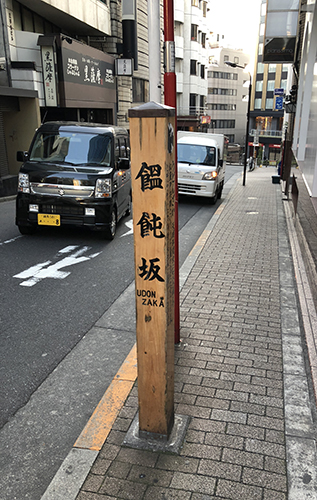Will Pedal for Food
What would you think if you pedaled across Tokyo, worked your way up a hill, and saw a street sign referring to sweet potatoes or udon? Chances are you'd be pretty excited. But not so fast. The signs I'm thinking of refer to food that once existed near certain hills—until around 1788 in one case! I'm guessing you like your udon fresher than that!
As in prior weeks, let's continue our examination of signposts on curiously named hills in Tokyo. I once again want to thank Russell Hogg for providing all the photos and stirring up my curiosity. (I explained the situation two blogs back.)
Sweet Potato Washing Hill
One of the aforementioned signs may not actually refer to sweet potatoes, in that 芋 can also mean just "potato," and it's impossible to know which one is meant here:
In fact, Wikipedia mentions a theory that this 芋 doesn't represent any vegetable at all. Instead, it symbolizes "pockmarks from smallpox." If so, then 芋洗い refers to the act of washing (洗) the pockmarks as part of a prayer to a Shinto god. But that theory seems far-fetched and certainly isn't the explanation on the signpost:

First we see the reading of the hill name 芋洗坂 (いもあらいざか), followed by the explanation of that name:
正しくは麻布警察署裏へ上る道をいったが、六本木交差点への道が明治以後にできて、こちらをいう人が多くなった、芋問屋があったからという。
The name actually referred to a slope behind the Azabu Police Station, but people mistakenly started using that name for this slope, a name that has become common today. The slope was built after the Meiji era and goes to Roppongi Intersection. There was a wholesale sweet potato shop near here, and that inspired the name.
正しく (ただしく: properly); 麻布 (あざぶ: place name); 警察署 (けいさつしょ: police station); 裏 (うら: behind); 上る (のぼる: to rise); 道* (みち: road); 六本木交差点 (ろっぽんぎこうさてん: Roppongi Intersection); 明治 (めいじ: Meiji (era), 1868–1912); 以後 (いご: after this); できる (to be built); こちら (here); 人 (ひと: person); 多く (おおく: many); 芋 (いも: sweet potato); 問屋 (とんや: wholesale store)
Udon
Moving from vegetables to noodles, we find udon (饂飩) in the next name, which is sure to have sparked vivid fantasies of chewy noodles:

On these signs one finds the yomi in both romaji and hiragana, and that's particularly helpful in this case because both 饂 and 飩 are non-Joyo. The explanation of the name unexpectedly refers back to 芋洗坂:
天明年間末(一七八八)頃まで、松屋伊兵衛という、うどん屋があったために、うどん坂と呼ぶようになった。昔の芋洗坂とまちがうことがある。
Until around 1788 there was an udon shop called Matsuya Ihee around here, so people came to call this slope Udon Hill. People sometimes mistake this slope for the one formerly known as Imoaraizaka.
天明 (てんめい: Tenmei (era), 1781–1789); 年間 (ねんかん: during an era); 末 (まつ: the end of); 一七八八 (いっせんななひゃくはちじゅうはち: 1788); 頃 (ごろ: around); 松屋伊兵衛 (まつや いへえ: name of a store, in which 伊 is non-Joyo); うどん屋 (うどんや: udon shop); うどん坂 (うどんざか: Udon Hill); 呼ぶ (よぶ: to call); 昔 (むかし: old); まちがう (間違う: to mistake)
The syntax of the last bit is AをBとまちがう (to mistake A for B). The A is “this slope" and is implied.
As long as we're talking about the food at the heart of things, be sure to check out the new Radical Note 199 on 麦, the "wheat" radical.
Catch you back here next time!
❖❖❖
Did you like this post? Express your love by supporting Joy o' Kanji on Patreon:




Comments